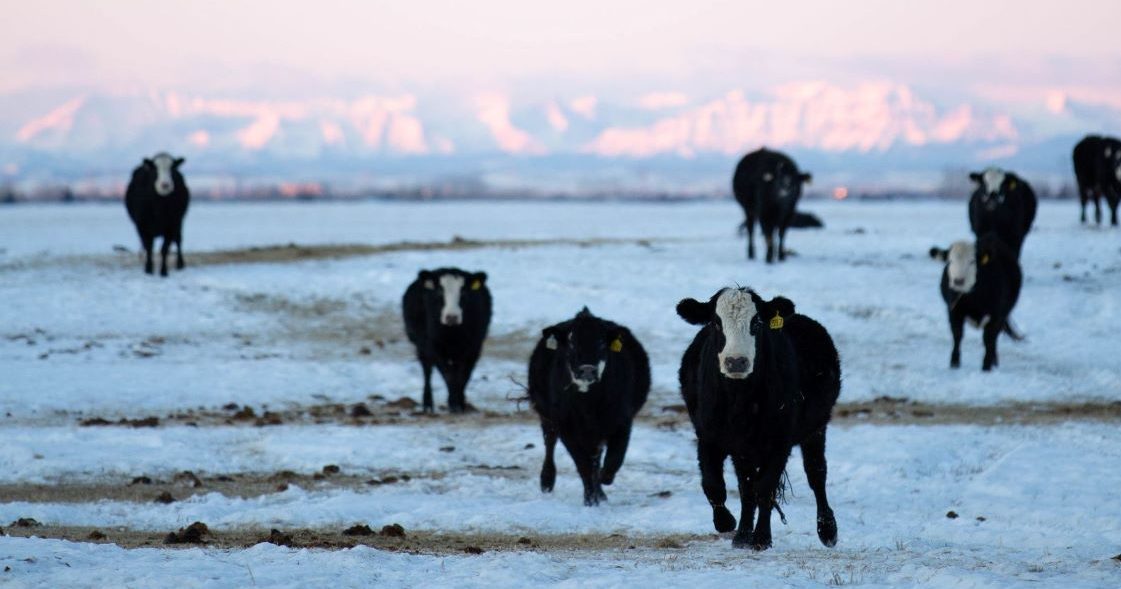AB Direct - Steers
Rail: 495.00 del
AB Direct - Heifers
Rail: 495.00 del
US Trade- Steers
Rail: 355.00-363.00 (IA, NE)
US Trade - Heifers
Rail: 355.00-363.00 (IA, NE)
Canadian Dollar
0.05

Ensure next gen success with proper heifer nutrition
Supporting bred heifer nutrition presents unique challenges. How can producers ensure bred heifers get high health scores, breed and rebreed successfully going into winter after a dry year? We spoke to ruminant nutritionist Lynne Girardin to collect some helpful advice.
When it comes to bred heifers, meeting nutritional requirements throughout gestation and beyond is primary. “We want a live calf, but we also want a healthy heifer who is able to rebreed, so we need to meet nutritional requirements both pre- and post-calving,” says Lynne Girardin, an independent consultant with BeefSmart, who works with producers to support animal nutrition.
Good nutrition meets the heifer’s need for energy and protein, plus vitamins and minerals. It starts with consideration of the heifer’s body condition scores and a test of the nutritional quality of available forages and grains. “When it comes to the bred heifer going into calving, we look for a body condition score of 2.5 to 3 on a 5-point scale. Getting that score is a direct reflection of pre-calving nutrition, but it also supports rebreeding success,” says Girardin.

Bred heifers are in a physiologically challenging time, still growing out their own frame, while also growing a fetus. Feeding plans need to consider both. “During this important time, we don’t want to limit energy, protein, vitamins or minerals,” says Girardin.
Nevertheless, drought and economics play a part, especially in a year like 2021. Many grain byproducts will be fed this winter, which presents benefits and other factors to consider. For example, supplementing with wheat cracks or oat hulls can increase nutritional quality, but beware of problems such as varying levels of minerals and common toxins (like ergot), which can still be a problem in a dry year.
Limited feed shifts the question
This season, limited feed supplies and diminishing profits have changed the question from what is ideal nutritionally to what is acceptable, given short supply. “There is such limited feed supply across the prairies and northern states. The biggest question I hear right now is: We have x number of bales and we have to feed them through to green grass next spring, so how many animals can we keep?” says Girardin.
A nutritionist can help producers do the math to refine winter feeding plans and ensure every animal is fed. “In a year like this one, we have to focus on protein and energy, because it will be lacking in our forages, and we’ll be using lower energy forages, like wheat or barley straw,” Girardin says.
Girardin suggests testing everything to ensure you’ve checked the essential boxes: “One beautiful advantage is we have an animal we can offer multiple types of feed. We can meet their protein and energy needs with almost all the byproducts and forages out there, we just have to know what we’re feeding.”
Consider minerals and vitamins too, she adds: “It’s very important not to forget these. Producers need to look not just at quantity but also at quality. Either deficiency or excess can lead to suboptimal reproduction of the bred heifer.”
In bred heifers, vitamin deficiency is one to watch out for. “Vitamin A, for example, plays an important role in embryo development, so it’s important to supplement throughout calving, and especially through this winter, when the drought has exacerbated the problem by extending the period when vitamins are lacking in forages,” says Girardin.
Seeking cost efficiency
Drought makes cost efficiency a higher priority. One strategy that can help is to ensure you don’t overfeed, increasing costs unnecessarily. “Using what you have on hand supports cost efficiency, but when there is a lack of quantity, quality becomes important, so look at the quality and supplement where you need to. Don’t just do what you’ve always done,” Girardin advises.
Another cost-saving strategy is looking at actual vitamin and mineral needs versus using a costly premix that contains more than you need. “If you can save five to 25 cents per head per day just based on your mineral premix, that may really make or break things this winter,” says Girardin.
Neighbours helping neighbours
Girardin laments with producers the challenges many are facing. “Some were hit with drought and then hailed out. They literally have no feed, and can’t find any either. The genetic pool of these herds takes years to build, and producers have pride in what they have. It’s terrible to have to practically give the animals away or sell them at a lower price because you don’t have enough feed,” Girardin says.
One helpful alternative may be asking neighbouring grain farmers for help. Using the limited value left in hailed out or drought stricken fields as animal feed can make a difference, feeding the animals, and building community.
“It’s great to see neighbours helping each other. Beef producers can subsidize some of what is needed on the crop side, and be grateful for the opportunity to use stubble or whatever is left of a drought stricken crop to maintain their herd,” says Girardin.
Bottom line requirements
In difficult times, it helps knowing there are multiple ways to meet bred heifer nutritional requirements, and Girardin encourages producers to spend some time penciling it out with a nutritionist to make best use of what is available.
“I never say there is only one way to feed cows or raise heifers. All we have to do is meet their requirements. Being creative, we can do so in a way that reduces cost, uses what is available, and supplements only where necessary,” she concludes.
This article was first published in Volume 1 Issue 4 edition of ABP Magazine (November 2021). Watch for more digital content from the magazine on ABP Daily.


